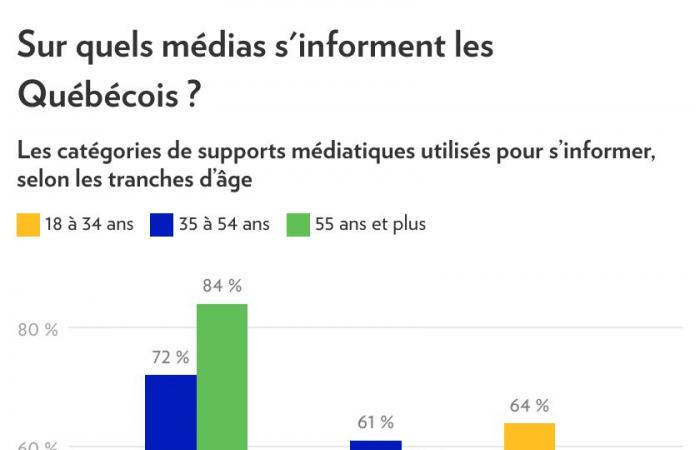Social media is young people’s preferred source of information, despite higher levels of trust in traditional media, according to a new survey.
Posted at 12:19 p.m.
Where do Quebecers get their information?
Nearly two-thirds of Quebecers obtain information daily, according to the NETendances survey by the Digital Transformation Academy.
Among older people, traditional media – television, radio and print – are still favored. Websites and information applications are also increasingly popular, but the divide with Internet users aged 18 to 34 is quite obvious; 64% of them get their information on social networks.
How do young people get information on social networks?
Nearly one in two young people (45% of 18 to 34 year olds) say they spend more than 3 hours a day on social networks. One format in particular has appealed to the younger generation: 77% of them regularly consume short vertical videos. Specific to TikTok, these videos are now at the heart of Instagram, Facebook and YouTube and are increasing the time spent on these platforms.
“This format, which promotes immediate gratification while offering personalized and varied content, creates an environment conducive to prolonged use,” notes the study.
According to the study, influencers are central to young people’s experience on social networks. 59% of 18 to 34 year olds say they follow at least one influencer. This proportion is likely to be much higher, explains Nataly Lévesque, doctor in influencer marketing at Laval University, since “the very definition of the term “influencer” remains unclear”.
Information influencers
According to a new study from the Pew Research Center, 37% of Americans under the age of 30 regularly get their news from news influencers. Factual, humorous, opinionated publications, or breaking news : a majority of these Internet users find that the information shared by information influencers is useful and that it is different from that shared by other sources of information.
These influencers – especially men – are found in the vast majority on X, but almost half are present on Instagram or YouTube. Most news influencers have no ties to media institutions.
Do Internet users know how to spot fake news?
Even though social media is becoming more and more important in the media diet of Quebecers, trust in traditional media remains higher, despite a decline in trust observed for several years.
“This decline translates into some narrowing of the gap with social media, especially among younger generations and people with a more conservative political orientation. Despite everything, the gap remains significant,” explains Colette Brin, director of the Center for Media Studies at Laval University.
While few Internet users trust the information reported on social networks, one in three people consider themselves capable of recognizing false news. Faced with this issue, more Internet users believe that platform moderation would be more effective than the development of critical thinking.
The study also shows that Internet users who demonstrate strong critical thinking are more likely to pay for news. Paid sources of information could be perceived as more reliable and of higher quality.
Check out the Digital Transformation Academy survey
Read the Pew Research Center study







